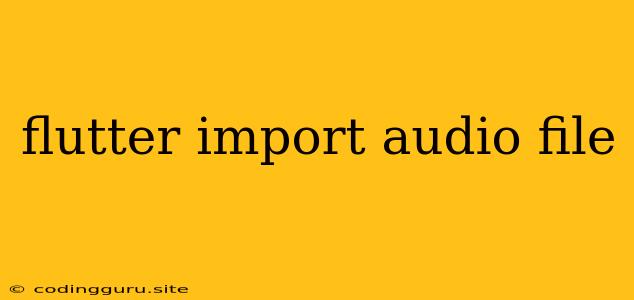Flutter: How to Import and Play Audio Files
Flutter is a popular cross-platform framework that allows you to build beautiful and engaging mobile apps. One common requirement in mobile app development is the ability to play audio files. This guide will walk you through the process of importing and playing audio files in your Flutter application.
The Basics of Audio Playback in Flutter
Before diving into the code, it's important to understand the basic concepts behind audio playback in Flutter. The core component for audio handling is the audio_player package. This package provides the necessary functionality to load, play, pause, and control audio files within your Flutter application.
Importing the audio_player Package
First, you need to add the audio_player package to your Flutter project's dependencies. This is typically done in your pubspec.yaml file:
dependencies:
flutter:
sdk: flutter
audioplayers: ^1.0.0
After adding the dependency, run flutter pub get to install the package.
Loading Audio Files
Now, let's explore how to load audio files within your Flutter app. Here's a simple example:
import 'package:audioplayers/audioplayers.dart';
class AudioPlayerScreen extends StatefulWidget {
@override
_AudioPlayerScreenState createState() => _AudioPlayerScreenState();
}
class _AudioPlayerScreenState extends State {
AudioPlayer _player = AudioPlayer();
@override
void initState() {
super.initState();
_loadAudio();
}
Future _loadAudio() async {
await _player.play('assets/audio/your_audio_file.mp3');
}
@override
Widget build(BuildContext context) {
return Scaffold(
appBar: AppBar(
title: Text('Audio Player'),
),
body: Center(
child: Column(
mainAxisAlignment: MainAxisAlignment.center,
children: [
ElevatedButton(
onPressed: () {
_player.play('assets/audio/your_audio_file.mp3');
},
child: Text('Play Audio'),
),
],
),
),
);
}
@override
void dispose() {
_player.dispose();
super.dispose();
}
}
This code does the following:
- Imports the
audioplayerspackage. - Creates an
AudioPlayerobject. - Loads the audio file in the
initState()method. - Provides a button to play the audio file.
- Disposes the
AudioPlayerobject in thedispose()method to release resources.
Important Considerations
- File Placement: The audio file (
your_audio_file.mp3in the example) should be placed in theassetsfolder of your Flutter project. Ensure you've addedassets/audio/to yourpubspec.yamlfile under thefluttersection. - Audio File Formats: The
audio_playerpackage supports various audio file formats, including MP3, WAV, and AAC. - Error Handling: It's essential to handle potential errors during audio loading and playback. You can use
try...catchblocks to catch exceptions.
Advanced Audio Controls
The audio_player package offers a wide range of audio controls, such as:
- Playing, pausing, and stopping audio.
- Controlling playback volume.
- Seeking to specific positions within the audio file.
- Getting information about the current audio playback state.
Here's an example of how to use these controls:
import 'package:audioplayers/audioplayers.dart';
class AudioPlayerScreen extends StatefulWidget {
@override
_AudioPlayerScreenState createState() => _AudioPlayerScreenState();
}
class _AudioPlayerScreenState extends State {
AudioPlayer _player = AudioPlayer();
bool _isPlaying = false;
double _volume = 1.0;
@override
void initState() {
super.initState();
_loadAudio();
}
Future _loadAudio() async {
await _player.play('assets/audio/your_audio_file.mp3');
}
@override
Widget build(BuildContext context) {
return Scaffold(
appBar: AppBar(
title: Text('Audio Player'),
),
body: Center(
child: Column(
mainAxisAlignment: MainAxisAlignment.center,
children: [
ElevatedButton(
onPressed: () async {
if (_isPlaying) {
await _player.pause();
} else {
await _player.resume();
}
setState(() {
_isPlaying = !_isPlaying;
});
},
child: Text(_isPlaying ? 'Pause' : 'Play'),
),
Slider(
value: _volume,
onChanged: (value) {
setState(() {
_volume = value;
_player.setVolume(_volume);
});
},
),
],
),
),
);
}
@override
void dispose() {
_player.dispose();
super.dispose();
}
}
This enhanced example allows you to pause, resume, and adjust the volume of the audio playback.
Playing Audio from URLs
You can also play audio files directly from URLs using the audio_player package:
import 'package:audioplayers/audioplayers.dart';
class AudioPlayerScreen extends StatefulWidget {
@override
_AudioPlayerScreenState createState() => _AudioPlayerScreenState();
}
class _AudioPlayerScreenState extends State {
AudioPlayer _player = AudioPlayer();
@override
void initState() {
super.initState();
_loadAudio();
}
Future _loadAudio() async {
await _player.play('https://www.example.com/audio_file.mp3');
}
@override
Widget build(BuildContext context) {
return Scaffold(
appBar: AppBar(
title: Text('Audio Player'),
),
body: Center(
child: Column(
mainAxisAlignment: MainAxisAlignment.center,
children: [
ElevatedButton(
onPressed: () {
_player.play('https://www.example.com/audio_file.mp3');
},
child: Text('Play Audio'),
),
],
),
),
);
}
@override
void dispose() {
_player.dispose();
super.dispose();
}
}
Conclusion
Integrating audio playback into your Flutter application is straightforward with the audio_player package. You can load audio files from local assets or remote URLs, control playback, adjust volume, and handle errors efficiently. This guide has provided a comprehensive overview of the process, equipping you with the necessary knowledge to add audio capabilities to your Flutter apps.
